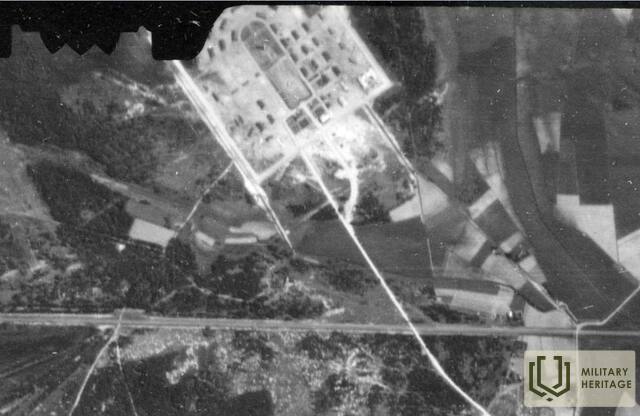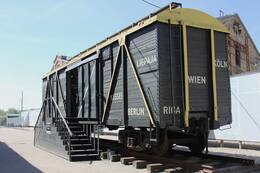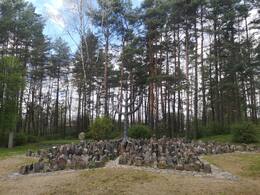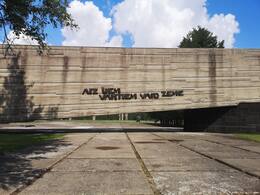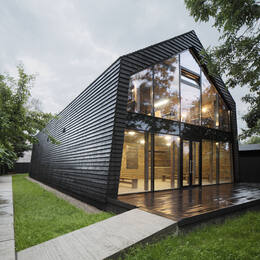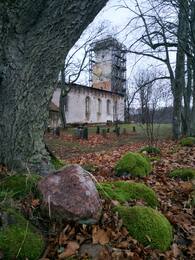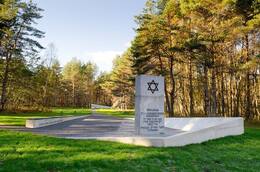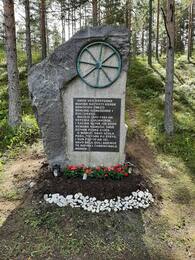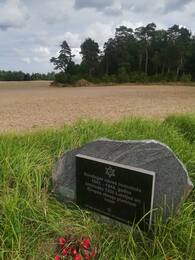Koncentracijos stovykla
I WW1, I Nepriklausomybės karai, Baltijos šalių nepriklausomybė, II Antrasis pasaulinis karas, IV Sovietų okupacija
Koncentracijos stovykla – tai po atviru dangumi esantis didelių žmonių masių izoliacijos įstaigų kompleksas, atskirtas nuo išorinio pasaulio ir saugomas – tai laikinų pastatų kompleksas, atskirtas nuo išorinio pasaulio ir saugomas, kuriame galima izoliuoti didelį skaičių civilių gyventojų arba nelaisvėje esančių kariškių (kovotojų), kurie yra nepageidaujami valstybei. Koncentracijos stovyklų paskirtis yra prevencinė: užkirsti kelią kariškiams ar civiliams (politiniams oponentams) imtis priešiškų valstybei ar režimui veiksmų, užkirsti kelią galimoms grėsmėms valstybei (ar režimui), kurias galėtų sukelti šių žmonių grupių buvimas plačiojoje erdvėje. Iki Antrojo pasaulinio karo koncentracijos stovyklos buvo laikomos priimtinu būdu izoliuoti dideles žmonių grupes karo ar neramumų sąlygomis. Tik po karo, kai buvo atskleista tiesa apie masinį mirtingumą nacių, o vėliau ir sovietų koncentracijos stovyklose, šis stovyklų terminas įgavo naują, jau itin neigiamą, prasmę.
Pirmąją žinomą „reconcentrados“ arba „koncentracijos stovyklą“ istorijoje 1895 m. įkūrė Ispanijos armijos generolas Valeriano Weileris, malšindamas sukilimą Kuboje. Tuomet koncentracijos stovyklas masiškai naudojo Britanijos armija vadinamojo Anglo-būrų karo (1899–1902 m.) metu. Pirmojo pasaulinio karo metu koncentracijos stovyklas steigė visos kariaujančios šalys, nes daugybė priešininkų kareivių pateko į įvairių armijų nelaisvę. Suomijoje pilietinio karo metu buvo įkurtos stovyklos Raudonosios armijos nelaisvėje esantiems kareiviams, o daugybė internuotųjų žuvo atšiauriomis šių stovyklų sąlygomis. Latvijos gyventojai taip pat buvo įgiję patirties arba supratimą apie tokias stovyklas dar prieš 1934 m. perversmą: daugelis Latvijos Rusijos imperatoriškosios armijos kareivių daugelį metų praleido karo belaisvių stovyklose Vokietijoje. Latvijos nepriklausomybės karo (1919–1920 m.) metu koncentracijos stovyklos buvo įkurtos Laikinosios vyriausybės ir Latvijos socialistų revoliucinės armijos kontroliuojamoje teritorijoje, kuriose buvo internuojami politiškai nepatikimi asmenys.
Rusijoje koncentracijos stovyklos pradėtos kurti 1919 m., vadovaujantis TSKP TKP balandžio 15 d. dekretu „Dėl pataisos darbų stovyklų įsteigimo“ (декрет „О лагерях принудительных работ“). 1934 m. Lenkijoje, po vidaus reikalų ministro Berezo nužudymo, Kartuškoje buvo įkurta koncentracijos stovykla, kurioje per penkerius metus buvo kalinamas 3091 kalinys – ukrainiečių ir lenkų nacionalistai, taip pat komunistai. Latvijos Respublikoje 1919 m. buvo įkurta vadinamoji Valmieros koncentracijos stovykla ir Liepojos koncentracijos stovykla. 1934 m. Antroje XX a. 4-ojo dešimtmečio pusėje iki Antrojo pasaulinio karo pabaigos naciai Vokietijoje sukūrė platų „Konzentrationslager“ tinklą, iš pradžių jį naudodami politinei opozicijai izoliuoti, vėliau karo belaisviams ir tiesiog režimui nepageidaujamiems asmenims įkalinti ir kaip vergišką darbo jėgą. Latvijoje buvo įkurtos Salaspilio, Jumpravmuižos ir Mežaparko koncentracijos stovyklos. Didelė dalis šių koncentracijos stovyklų toliau veikė ir po Vokietijos kapituliacijos, tik pakeitus kalinių kontingentą. SSRS okupacinėje zonoje stovyklos 1948 m. buvo perduotos GULAG'o administracijai, tačiau 1950 m. buvo likviduotos (stovyklos įranga buvo išvežta į SSRS, kur toliau buvo naudojama GULAG'o koncentracijos stovyklose).
Daugiau informacijos šaltinių
https://vesture.eu/Koncentr%C4%81cijas_nometne
https://lv.wikipedia.org/wiki/Kategorija:Tre%C5%A1%C4%81_reiha_koncentr%C4%81cijas_nometnes_Latvij%C4%81
Susijusi laiko juosta
Susijusios vietos
Rygos getas ir Latvijos Holokausto muziejus
Rygos geto ir Latvijos Holokausto muziejus yra įsikūręs Rygoje, netoli Rygos centrinio turgaus ir Rygos centrinės stoties. Muziejus buvo atidarytas 2010 m. toje vietoje, kur anksčiau buvo miesto sandėliai. Jis įsikūręs istorinėje miesto dalyje, šalia buvusio žydų geto sienos. Geto teritorija yra unikali, nes architektūros požiūriu ji nepasikeitė nuo Antrojo pasaulinio karo. Tai memorialas, skirtas žydų tautos tragedijai. Vokietijos politika žydų gyventojų atžvilgiu Latvijoje iki 1939 m. pabaigos buvo tokia, kad Vokietijos diplomatai ir politikai bandė daryti spaudimą Latvijos vyriausybei, kad ši imtųsi veiksmų prieš žydus, apribodama jų laisvę. Po Baltijos vokiečių emigracijos 1939 m. Vokietijos ambasada nebeturėjo tokios geros prieigos prie informacijos apie gyventojų nuotaikas ir įvykius Latvijoje kaip anksčiau. Kai Raudonoji armija okupavo Latviją, ji manipuliavo visuomene, kad gautų žydų gyventojų paramą naujajai okupacinei valdžiai. Tačiau po to, kai režimas pradėjo represijas prieš visą visuomenę, parama sparčiai sumažėjo. Dėl viso to tarp žmonių susiformavo gilus susiskaldymas. Vėliau kitas režimas – Vokietija – bandė tuo pasinaudoti. Jie tikėjosi, kad vietos gyventojai persekios ir puls žydus, tačiau taip neatsitiko. Taigi, Vokietija pakoregavo savo požiūrį ir parengė naują planą – iš pradžių įkurti žydų getą, o vėliau sunaikinti jo gyventojus.
Žydų memorialas Rumbule
Įsikūręs Rumbuloje, netoli Maskavas gatvės.
Rumbula yra viena didžiausių masinio žydų naikinimo vietų Europoje. Per dvi akcijas – 1941 m. lapkričio 30 d. ir gruodžio 8 d., kurios buvo įvykdytos remiantis nacių vadovybės sprendimu visiškai sunaikinti Rygos gete kalintus žydus, Rumbulos miške buvo sušaudyta daugiau nei 25 000 žmonių, įskaitant apie 1000 iš Vokietijos deportuotų žydų. 1944 m. Rumbuloje taip pat buvo nužudyti keli šimtai žydų vyrų iš Kaiservaldo koncentracijos stovyklos.
Pirmieji bandymai įamžinti Rumbuloje nužudytų žydų atminimą datuojami septintojo dešimtmečio pabaiga. Nepaisant sovietų valdžios apribojimų, pavienių žydų iniciatyva 1963 m. prie vienos iš Rumbulos pušų buvo pritvirtinta medinė atminimo lenta su užrašu jidiš kalba, o prie Rumbulos geležinkelio (netoli Rygos–Maskvos linijos) buvo įrengtas didelis menininko Josifo Kuzkovskio plakatas „Žydas“. Plakate buvo pavaizduotas vyras, tarsi kylantis iš kapo sugniaužtu kumščiu, simbolizuojantis protestą prieš tai, kas buvo padaryta. Ir atminimo lenta, ir plakatas buvo pašalinti 1964 m., tačiau žydams pavyko gauti leidimą įrengti Rumbuloje atminimo akmenį su užrašu „Fašizmo aukoms“ ne tik latvių ir rusų kalbomis, bet ir jidiš kalba.
2002 m. lapkričio 29 d. Rumbuloje atidarytas architekto Sergejaus Rižo suprojektuotas memorialinis ansamblis. Jo statybą finansiškai parėmė Latvijos, Izraelio, JAV ir Vokietijos institucijos bei privatūs asmenys.
Pakelėje, prie kelio, vedančio į memorialą, pastatyta metalinė konstrukcija kaip ženklas, simbolizuojantis nacizmo pajėgas. Netoliese yra akmuo su paaiškinimu, kad šiuo keliu buvo mirtinai suvaryti tūkstančiai žydų. Prie įėjimo į memorialą kelios akmeninės lentelės su užrašais latvių, anglų, vokiečių ir hebrajų kalbomis supažindina su Rumbulos tragedijos įvykiais ir memorialo įkūrimo istorija. Centrinėje memorialo dalyje, virš aikštės, kuri yra Dovydo žvaigždės formos, kyla septynšakė žvakidė – menora, aplink kurią sudėti akmenys su Rumbulos nužudytų žydų vardais. Atskiruose akmenyse iškalti buvusio Rygos geto gatvių pavadinimai, kuriais išgrįsta aikštė. Memorialo teritorijoje yra keletas masinių kapaviečių, kurių vietos pažymėtos stačiakampiais betoniniais bordiūrais.
Salaspilio memorialinis ansamblis
Salaspilio memorialas ir istorinė ekspozicija yra Salaspilio savivaldybėje, 1,2 km nuo Rygos–Daugpilio greitkelio A6. Salaspilio memorialas buvo atidengtas 1967 m. toje vietoje, kur Antrojo pasaulinio karo metu buvo įsikūrusi Salaspilio stovykla. Tai vieta, kuri buvo naudojama sovietinei propagandai ir yra apipinta mitais bei pusinėmis tiesomis. Tai geras nacių nusikaltimų ir komunistinės ideologijos, vykdytos kiekvienos okupacijos metu, atvaizdas. Ši represinė stovykla buvo Vokietijos pataisos sistemos dalis. Ji turėjo panašumų su koncentracijos stovyklomis, bet tai nebuvo tas pats. Ji buvo sukurta tam, kad Rygos kalėjimuose nebūtų neproporcingai daug kalinių. Ši stovykla buvo „policijos kalėjimo tęsinys“. Čia buvo kalinami įvairūs žmonės – žydai, Raudonosios armijos karo belaisviai, pravaikštos dalyviai, politiniai kaliniai, nusikaltėliai, prostitutės, Latvijos pasipriešinimo judėjimo nariai, Baltijos šalių kareiviai Vokietijos armijoje ar policijoje ir kiti. Stovykloje galėjo kalėti iki 2200 kalinių. Pagrindinė mirties priežastis (apie 2000 m.) buvo nepakankama mityba, darbo sąlygos, fizinės bausmės ir ligos.
Žanio Lipkės memorialas
Žanio Lipkės memorialas yra Kipsaloje, Rygoje. Žanio Lipkės muziejus yra bene vienas labiausiai paslėptų muziejų Rygoje. Nesuprantama memorialo vieta nėra atsitiktinumas ir turi simbolinę reikšmę. Jis įrengtas buvusios požeminės slėptuvės, kuri buvo sukurta žmonėms gelbėti Antrojo pasaulinio karo vokiečių okupacijos metu, vietoje. Čia Žanis Lipke ir jo šeima išgelbėjo 55 žydus. Šiandien memorialas pastatytas šalia Žanio Lipkės šeimos namo. Memorialas „Juodasis tvartas“ yra simbolinis pastatas, kuriame buvo teikiama ir priimama prieglauda. Pastato dizainas buvo paimtas iš istorinių Kipsalos žvejų ir jūreivių degutu dengtų trobelių. Šios trobelės buvo pastatytos naudojant baržų medžiagas, todėl jos turėjo labai savitą spalvą ir deguto kvapą. Tačiau unikali ne tik šios istorinės vietos istorija. Taip pat pastebimas ir tai, kaip muziejus perteikia savo žinią. Bendras dizainas panašus į Biblijoje aprašytą Nojaus arką, be to, jis primena į krantą ištrauktą ir apvirtusią valtį – valtį, kuri atliko savo užduotį. Šio memorialo koncepcija kyla iš šios vietos ir istorijos istorinio tikslumo bei su ja susijusių liudijimų. Tai istorija apie laisvės troškimą, neįtikėtiną pabėgimą ir pasitikėjimą. Pakeliui į muziejų taip pat galėsite pamatyti istorinius Pardaugavos pastatus.
Raudonosios armijos kalinių filtracijos stovykla Griezėje ir Griezės bažnyčia
Griežė yra Latvijos ir Lietuvos pasienyje, kur Vadakstės upė įteka į Ventą. Griežės bažnyčia buvo pastatyta 1580 m., tačiau parapija egzistavo dar iki 1567 m. Bažnyčia buvo kelis kartus perstatyta – 1769 m., 1845 m., o 1773 m. buvo įrengti pirmieji vargonai. Dėl įvairių priežasčių prarastas ir altorius, ir du varpai.
Bažnyčios sode yra kapinės, kuriose palaidoti bažnyčiai priklausę žmonės ir didikai. Vienas iš jų – „Grieze“ vargonininkas Friedrichas Barisas ir jo žmona Šarlotė, kuriems priešais bažnyčios zakristiją pastatytas paminklas. Pietinėje bažnyčios pusėje palaidoti 32 švedų kareiviai, žuvę Didžiajame Šiaurės kare. Kapinėse taip pat yra 110 vokiečių kareivių, žuvusių Pirmajame pasauliniame kare, kapai, kuriems 1930 m. pastatytas paminklas.
Antrojo pasaulinio karo metu bažnyčia nukentėjo, kai 1944 m. spalio pabaigoje fronto linija buvo ištempta palei Ventos upę, o Griezės bažnyčios apylinkėse buvo dislokuota vokiečių 225-oji pėstininkų divizija. Kai 1944 m. lapkričio 19 d. sovietų 4-oji smogiamoji armija pradėjo atakas per Ventos upę, keli artilerijos sviediniai pataikė į bažnyčios pietinę sieną, o bažnyčios bokštas buvo smarkiai apgadintas.
Po armijų grupės „Kurzeme“ kapituliacijos Raudonosios armijos Leningrado fronte į nelaisvę pateko 284 171 žmogus. 7493 buvo Raudonosios armijos kareiviai, paleisti iš vokiečių nelaisvės. Į nelaisvę pasidavė 48 vokiečių generolai. Remiantis armijų grupės „Kurzeme“ kapituliacijos metu pateiktais dokumentais, kareivių skaičius buvo apie 185 000. Likę iš beveik 100 000 filtruotinų žmonių buvo Kuržemės civiliai gyventojai ir sovietiniai pabėgėliai, nes 1945 m. gegužės 10 d. Sovietų Sąjungos Leningrado frontas įsakė filtruoti visus vyrus nuo 16 iki 60 metų amžiaus.
Raudonojoje armijoje, skirtingai nei kitų šalių ginkluotosiose pajėgose, karo belaisvių patikrą, apsaugą, priežiūrą ir priežiūrą vykdė ne armijos daliniai, o vidaus reikalų organai – Valstybės saugumo liaudies komisariatas. Pagrindinė filtracijos užduotis buvo aptikti SSRS ir sovietų okupuotų šalių piliečius, dalyvavusius karo veiksmuose Vokietijos pusėje. Buvo tiriami paimti į nelaisvę vokiečių kareiviai, siekiant nustatyti galimus karo nusikaltimų vykdytojus.
Nuo 1945 m. gegužės 10 d. iki birželio 17 d. netoli Griezės bažnyčios buvo įsikūrusi karo belaisvių filtracijos stovykla. Stovykla tikriausiai čia buvo įsikūrusi todėl, kad Griezės bažnyčia buvo netoli pagrindinių kelių. Apylinkėse vis dar aiškiai matomos duobės žemėje, kuriose kaliniai šaltomis naktimis slėpdavosi nuo šalčio, prisidengdami kuo tik pavykdavo. Šiuo laikotarpiu Raudonoji armija padarė didelę žalą bažnyčios interjerui (visi suolai buvo pašalinti – „karo reikmėms“, apgadinta sakykla, sunaikinti vargonai ir kt.). Pačiame bažnyčios pastate buvo įrengta skalbykla.
Paskutinės pamaldos bažnyčioje įvyko 1950 m., ir parapija nustojo egzistuoti. Po parapijos iširimo, vėliau prižiūrint Latvijos gamtos ir paminklų apsaugos draugijai, bažnyčia nebuvo suremontuota. Tačiau pastatas po stogu stovėjo iki septintojo–septintojo dešimtmečių. Bažnyčia buvo apgadinta per 1961 m. audrą, o 1968 m. likusius interjero elementus išgelbėjo Rundalės rūmų darbuotojai.
Nuo 2003 m. grupė bendraminčių iš Rygos parapijų dalyvauja bažnyčios tvarkymo ir restauravimo darbuose. Iki šiol bažnyčios sienos yra konservuotos, o bokštas restauruotas.
Klogos koncentracijos stovykla ir holokausto memorialas
Šis Holokausto aukų memorialas yra netoli nedidelio Kloogos miestelio.
Pirmasis paminklas čia buvo pastatytas 1951 m., tačiau jame iš esmės buvo šlovinama sovietinė ideologija ir mažai dėmesio skirta Holokausto aukoms atminti. 1994 m. Estijos žydų bendruomenės prašymu paminklo lentelės buvo pakeistos naujomis, siekiant pagerbti aukų etnines šaknis. Minint 50-ąsias masinių žudynių Kloogoje metines, 100 metrų atstumu nuo pirmojo paminklo buvo atidengtas paminklas 1941–1944 m. Estijoje nužudytiems žydams. 2005 m. buvo atidengtas trečiasis paminklas, skirtas atminti Kloogos koncentracijos stovykloje žuvusius ar nužudytus žydus.
Memorialas buvo renovuotas 2013 m., siekiant sujungti tris paminklus, o Estijos istorijos muziejus čia atidarė lauko parodą pavadinimu „Kloogos stovykla ir Holokaustas“.
Kloogos koncentracijos stovyklą vokiečių režimas įkūrė 1943 m. rugsėjį. Tai buvo priverstinio darbo stovyklos dalis, priklausanti Vaivaros koncentracijos stovyklos kompleksui Estijoje. 1944 m. rugsėjo 19 d. buvo įvykdyta viena didžiausių masinių žudynių vokiečių okupuotoje Estijoje: artėjant Raudonajai armijai buvo nužudyti visi stovykloje buvę žydai (iš viso apie 2000).
Memorialas Jägala/Kalevi-Liiva koncentracijos stovyklos aukoms atminti
Šis paminklas yra Kaberneeme kaime.
Atidengtas 1960 m., jis skirtas atminti žydus, nužudytus koncentracijos stovykloje Jägaloje 1942 ir 1943 m. Ją sukūrė P. Madalikas.
Jägalos koncentracijos stovyklą vokiečių režimas įkūrė 1942 m. rugpjūtį. Tų metų rugsėjį į ją traukiniais iš visos Europos buvo atgabenta apie 2200 kalinių. Dauguma jų buvo sušaudyti atvykę į netoliese esantį Kalevi-Liiva poligoną; likusieji buvo priversti dirbti. Iš viso žuvo apie 2000 žmonių. Stovykla buvo uždaryta 1943 m. rugsėjį, o likę kaliniai perkelti į Talino centrinį kalėjimą Patarei jūros tvirtovėje.
Susijusi istorija
Apie Salaspilio memorialą kaip sovietinio okupacinio režimo ideologijos simbolį.
Aprašyme vaizdžiai aprašomas memorialinės vietos politizavimo mastas ir jos vaidmuo Sovietų Sąjungos ideologijoje. Tekste minima, kad vienas iš pagrindinių tikslų – kova su „fašizmo atgimimu“. Tai rodo, kad ideologinė infrastruktūra ir toliau naudojama komunistų nusikaltimams slėpti ir kitaip mąstančiųjų nuomonei uždrausti. Memorialinės vietos, sovietų armijos kapinės ir muziejai, įvairūs kultūriniai renginiai palaikė „Latvijos išvadavimo“ ir „broliškos Sovietų Sąjungos“ mitą. Nacių nusikaltimų faktai buvo panaudoti kuriant iškreiptą Antrojo pasaulinio karo įvykių Latvijoje vaizdą.
Apie vaikų kolonijos „Rūķīši“ įvykius prieškario ir Antrojo pasaulinio karo laikotarpiais
Vaikai buvo atimti iš partizanų rėmėjų šeimų. 1943 m. kovo mėn. Salaspilio stovykloje buvo 1100 vaikų. Apie 250 vaikų mirė nuo tymų, vidurių šiltinės ir kitų ligų, keli šimtai vaikų buvo perkelti į aplinkinių parapijų ūkius, o apie 300 vaikų atsidūrė vaikų namuose Rygos Jūrmaloje, Igatėje ir Saulkrastuose.
Saulkrastuose vaikai atsidūrė Latvijos vaikų pagalbos draugijos vaikų kolonijoje „Rūķīši“.
Dovydo žvaigždė Dundagos koncentracijos stovyklos memorialinėje vietoje
Atgavę nepriklausomybę, Dundagos gyventojai žydų žudymo ir perlaidojimo vietoje prie Mazirbės–Dundagos kelio pastatė didelę medinę Dovydo žvaigždę, o vėliau Latvijos žydų kongregacijų ir bendruomenių taryba šalia jos taip pat atidengė atminimo akmenį.




